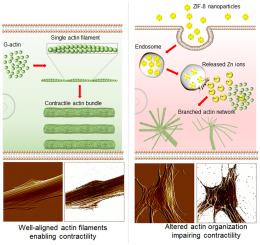Journal of Hazardous Materials ( IF 12.2 ) Pub Date : 2021-02-24 , DOI: 10.1016/j.jhazmat.2021.125514 Divya Kota 1 , Lin Kang 1 , Alex Rickel 2 , Jinyuan Liu 1 , Steve Smith 1 , Zhongkui Hong 2 , Congzhou Wang 1

|
Zeolitic imidazolate framework-8 (ZIF-8) nanoparticles have emerged as a promising platform for drug delivery and controlled release. Considering most ZIF-8 nanoparticle drug carriers are designed to be administered intravenously, and thus would directly contact vascular smooth muscle cells (VSMCs) in many circumstances, the potential interactions of ZIF-8 nanoparticles with VSMCs require investigation. Here, the effects of low doses of ZIF-8 nanoparticles on VSMC morphology, actin organization, and contractility are investigated. Two nanoscale imaging tools, atomic force microscopy, and direct stochastic optical reconstruction microscopy, show that even at the concentrations (12.5 and 25 µg/ml) that were deemed “safe” by conventional biochemical cell assays (MTT and LDH assays), ZIF-8 nanoparticles can still cause changes in cell morphology and actin cytoskeleton organization at the cell apical and basal surfaces. These cytoskeletal structural changes impair the contractility function of VSMCs in response to Angiotensin II, a classic vasoconstrictor. Based on intracellular zinc and actin polymerization assays, we conclude that the increased intracellular Zn2+ concentration due to the uptake and dissociation of ZIF-8 nanoparticles could cause the actin cytoskeleton dis-organization, as the elevated Zn2+ directly disrupts the actin assembly process, leading to altered actin organization such as branches and networks. Since the VSMC phenotype change and loss of contractility are fundamental to the development of atherosclerosis and related cardiovascular diseases, it is worth noting that these low doses of ZIF-8 nanoparticles administered intravenously could still be a safety concern in terms of cardiovascular risks. Moving forward, it is imperative to re-consider the “safe” nanoparticle dosages determined by biochemical cell assays alone, and take into account the impact of these nanoparticles on the biophysical characteristics of VSMCs, including changes in the actin cytoskeleton and cell morphology.
中文翻译:

低剂量的沸石咪唑酯骨架 8 纳米颗粒改变了血管平滑肌细胞的肌动蛋白组织和收缩性
沸石咪唑酯骨架 8 (ZIF-8) 纳米颗粒已成为一种有前途的药物递送和控释平台。考虑到大多数 ZIF-8 纳米颗粒药物载体设计为静脉内给药,因此在许多情况下会直接接触血管平滑肌细胞 (VSMC),因此需要研究 ZIF-8 纳米颗粒与 VSMC 的潜在相互作用。在这里,研究了低剂量 ZIF-8 纳米粒子对 VSMC 形态、肌动蛋白组织和收缩性的影响。两种纳米级成像工具,原子力显微镜和直接随机光学重建显微镜,表明即使在常规生化细胞测定(MTT 和 LDH 测定)认为“安全”的浓度(12.5 和 25 µg/ml)下,ZIF-8 纳米粒子仍可引起细胞顶端和基底表面的细胞形态和肌动蛋白细胞骨架组织的变化。这些细胞骨架结构变化损害了血管平滑肌细胞响应血管紧张素 II(一种经典的血管收缩剂)的收缩功能。基于细胞内锌和肌动蛋白聚合测定,我们得出结论,增加的细胞内锌由于 ZIF-8 纳米粒子的吸收和解离导致的2+浓度可能导致肌动蛋白细胞骨架解体,因为升高的 Zn 2+直接破坏肌动蛋白组装过程,导致肌动蛋白组织改变,例如分支和网络。由于 VSMC 表型变化和收缩力丧失是动脉粥样硬化和相关心血管疾病发展的基础,值得注意的是,这些低剂量的 ZIF-8 纳米颗粒静脉内给药仍可能是心血管风险方面的安全问题。展望未来,必须重新考虑仅由生化细胞测定确定的“安全”纳米颗粒剂量,并考虑这些纳米颗粒对 VSMC 生物物理特性的影响,包括肌动蛋白细胞骨架和细胞形态的变化。











































 京公网安备 11010802027423号
京公网安备 11010802027423号